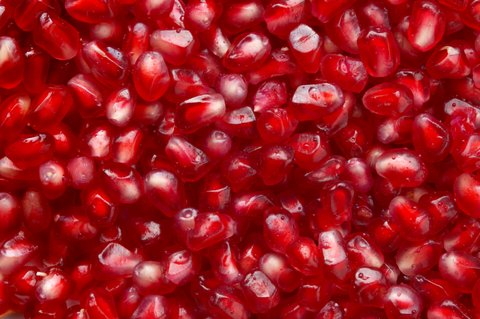The pomegranate is one of the most visually striking and intriguing of fruits. It is featured in recipes for Chiles en Nogada, a traditional recipe served during Mexico’s Independence celebrations in September, which tie in with the pomegranate harvest season.

Recent studies indicate that pomegranates are heart healthy additions to the diet and that they play a role in reducing cancer risks. Researchers have found that the concentrated polyphenols (antioxidants) and phytonutrients present in pomegranates may restore endothelial health, lower blood pressure, increase nitric acid synthesis, and generally provide protection to the cardiovascular system. Pomegranates appear to protect LDL (low-density lipids, or “bad” cholesterol) from oxidative breakdown and to reduce existing formations of atherosclerotic plaque on the arterial walls, something many previously thought impossible. Pomegranates also appear to play a role in suppressing the progress of prostate cancer by increasing the rate of cancer cell death and possibly reducing the risk of other cancers such as colon, lung, and breast cancers.
The pomegranate tree is bushy with multiple stems growing to no more than twenty or thirty feet. The pomegranate is native to Asia, extending from Iran through northern India, and was cultivated in the Mediterranean regions of Europe, Asia, and Africa. It was brought to the New World with the early settlers. Despite its small size and apparent fragility, it is known as a long-living tree. Specimens in France have been identified as being more than two centuries old.
After conquering Granada, Queen Isabella is reported to have stood with a pomegranate in her hand and declared, “Just like the pomegranate, I will take over Andalusia seed by seed.”
Source URL: http://www.pomwonderful.com/pomegranate-wellness/history/3500-500-bc/
The pomegranate, or granada¸ as it is known in Spanish, is now grown in the cooler and drier interior highlands of Honduras and Mexico. Spanish settlers introduced the pomegranate into California in the eighteenth century, and it is cultivated in Arizona. The pomegranate likes hot, dry summers and cool winters.
In Mexico, the pomegranates of Tehuacan, Puebla, are the most prized. Some of the Mexican cultivars are “Granada de China” and the “Granada Agria,” meaning sour or tart pomegranate.
There are many varieties grown with different ranges of sweetness, color intensity, and juiciness. Some varieties have harder seeds and are more fibrous than others are. Some varieties are pinkish-white, and others are blood red; some are richly sweet, and some are decidedly tart and acidic, containing high levels of Vitamin C.
Although most studies and interest these days are concentrated on the fruit (seeds) and juice of the pomegranate, traditionally, the bark, root, and rind of the fruit was used in folk medicine in Asia, the Middle East, and in the early days of its cultivation in the New World.
In one of the classic books on Mexican medicinal plants, Las Plantas Medicinales de Mexico (Mexico, Ediciones Botas 1969), Professor Maximino Martinez says of Punica granatum L. that the only part used of the pomegranate is the root bark for the expulsion of tapeworms. However, these parts of the tree are high in tannins and best avoided.
Pomegranate juice is widely available alone and mixed with other fruit juices; an extract is available in powder form or as pills and capsules.
Releasing the Seeds and Extracting the Juice
The easiest way of extracting the seeds from a pomegranate and separating them from the white membrane with which they seem inextricably entwined, is to cut off the top of the pomegranate and then carefully score downward into the rind several times without cutting into the seeds so that they remain intact. Soak the pomegranates in cold water, top down, for ten or fifteen minutes. Leaving the fruit in the water, break apart the rind carefully and release the seeds with your fingers, trying not to rupture them. The rind and buoyant white fibrous membrane should float to the top while the heavier seeds fall to the bottom, letting you skim off the membrane and rind and strain the cleaned seeds through a sieve or colander. Dry the seeds on a towel and they’re ready to use.
The easiest way to juice a pomegranate is pressing the halved fruits with a common citrus press. The Mexican style pull-down arm juicer works well. When we were in the Spice Bazaar in Istanbul, that was how the juice stands in the area produced intensely tart, red, pure pomegranate juice in seconds flat, with very little waste. The resulting juice was run quickly through a small sieve to remove any stray bits of membrane and rind.
The extracted juice or the unbroken seeds (juice sacs) may be frozen intact for future use. In northern India, the juice sacs are sun-dried for ten to fifteen days and sold as a spice called anardana.
I felt my heart crack slowly like a pomegranate, spilling its seeds.
―Trebor Healey, A Horse Named Sorrow
Since ancient times, the pomegranate has symbolized fertility, good luck, and abundance to the Chinese, Greeks, and Arabs. Read the tale of Persephone and the Pomegranate, a “metaphor for the continual cycle of growth, dormancy, and regrowth which governs all things in the physical realm.” (http://www.aseekersthoughts.com/2009/12/pomegranate-symbol-and-myth.html)
Sources:
- Dave Tuttle, “Pomegranate Reverses Atherosclerosis and Slows the Progression of Prostate Cancer,” Life Extension Magazine, http://www.lef.org/magazine/mag2007/feb2007_report_pomegranate_01.htm
- “Health benefit of pomegranate juice on prostate cancer and the heart,” Harvard Health Publications, Harvard Medical School, http://www.health.harvard.edu/press_releases/health-benefit-of-pomegranate-juice
- “Pomegranate juice consumption reduces oxidative stress, atherogenic modifications to LDL, and platelet aggregation: studies in humans and in atherosclerotic apolipoprotein E–deficient mice,” American Journal of Clinical Nutrition (From the Lipid Research Laboratory and the Division of Morphological Sciences, Technion Faculty of Medicine, The Rappaport Family Institute for Research in the Medical Sciences and Rambam Medical Center, Haifa, Israel), http://ajcn.nutrition.org/content/71/5/1062.full
- “Pomegranate,” University of Maryland Medical Center http://umm.edu/health/medical/altmed/herb/pomegranate#ixzz33cGIisI3
University of Maryland Medical Center - Morton, J. “Pomegranate,” in Fruits of Warm Climates“ (1987) from Purdue University website, http://www.hort.purdue.edu/newcrop/morton/pomegranate.html